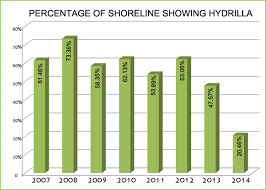The 2014 volunteer survey of Hydrilla in Lake Gaston shows the largest drop in the presence of the noxious weed since 2007, when the first survey was done. The survey, conducted by members of the Lake Gaston Association, shows only 20.46 percent of the shoreline with Hydrilla. In 2013 the figure was 47.57 percent and in 2008, more than 73 percent had Hydrilla.

In addition to the drop in the coverage area, the survey found the average length of Hydrilla fronds down to a little over an inch. In previous years, Hydrilla fronds averaged more than a foot. Only six points had Hydrilla that had “topped out” and four of those were in Lizzard Creek.
The report of the volunteer survey, along with a “hydro acoustic survey,” was presented to the Lake Gaston Association on Wednesday by  Dr. Brett M. Hartis, the Aquatics Extension and Research Associate with the Department of Crop Science at North Carolina State University. Dr. Hartis helped coordinate the volunteer survey and conducted the “hydro acoustic survey.”
Dr. Brett M. Hartis, the Aquatics Extension and Research Associate with the Department of Crop Science at North Carolina State University. Dr. Hartis helped coordinate the volunteer survey and conducted the “hydro acoustic survey.”
Dr. Hartis credits “two good weather years” for part of the drop. Cooler and wetter months contributed to the decline, he said. And he also credits grass carp for a significant contribution, especially to the fact that even when Hydrilla was found, it was much shorter than in past years. He said, “We’ve met our goal with grass carp.”
The survey was conducted at points about every 200 feet along the more than 350 miles of shoreline along Lake Gaston. Using portable GPS units, volunteers recorded what weeds were found and how long they were.
Dr. Hartis also announced that after three years working with Lake Gaston, he will be leaving in January to take a job with the Tennessee Valley Authority. He indicated he is working with N.C. State to help find his replacement. He was given a standing ovation at the conclusion of his presentation.





